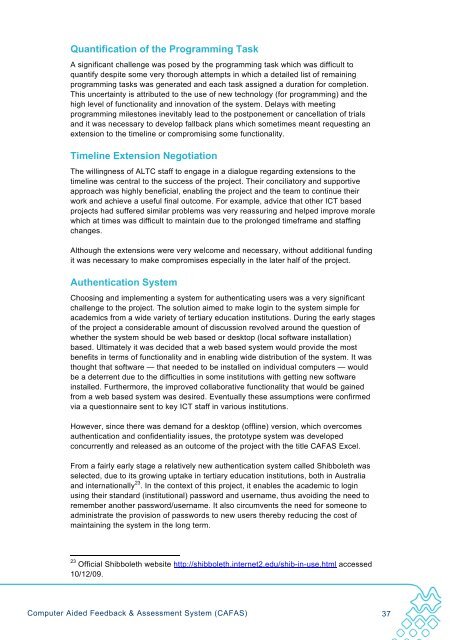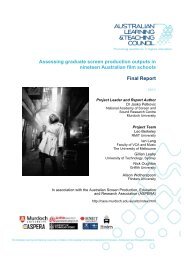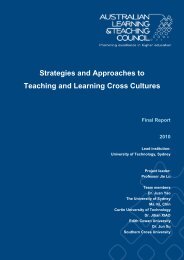PP654 UniSa Freney - Final Report Feb 2010.pdf - Office for ...
PP654 UniSa Freney - Final Report Feb 2010.pdf - Office for ...
PP654 UniSa Freney - Final Report Feb 2010.pdf - Office for ...
You also want an ePaper? Increase the reach of your titles
YUMPU automatically turns print PDFs into web optimized ePapers that Google loves.
Quantification of the Programming TaskA significant challenge was posed by the programming task which was difficult toquantify despite some very thorough attempts in which a detailed list of remainingprogramming tasks was generated and each task assigned a duration <strong>for</strong> completion.This uncertainty is attributed to the use of new technology (<strong>for</strong> programming) and thehigh level of functionality and innovation of the system. Delays with meetingprogramming milestones inevitably lead to the postponement or cancellation of trialsand it was necessary to develop fallback plans which sometimes meant requesting anextension to the timeline or compromising some functionality.Timeline Extension NegotiationThe willingness of ALTC staff to engage in a dialogue regarding extensions to thetimeline was central to the success of the project. Their conciliatory and supportiveapproach was highly beneficial, enabling the project and the team to continue theirwork and achieve a useful final outcome. For example, advice that other ICT basedprojects had suffered similar problems was very reassuring and helped improve moralewhich at times was difficult to maintain due to the prolonged timeframe and staffingchanges.Although the extensions were very welcome and necessary, without additional fundingit was necessary to make compromises especially in the later half of the project.Authentication SystemChoosing and implementing a system <strong>for</strong> authenticating users was a very significantchallenge to the project. The solution aimed to make login to the system simple <strong>for</strong>academics from a wide variety of tertiary education institutions. During the early stagesof the project a considerable amount of discussion revolved around the question ofwhether the system should be web based or desktop (local software installation)based. Ultimately it was decided that a web based system would provide the mostbenefits in terms of functionality and in enabling wide distribution of the system. It wasthought that software — that needed to be installed on individual computers — wouldbe a deterrent due to the difficulties in some institutions with getting new softwareinstalled. Furthermore, the improved collaborative functionality that would be gainedfrom a web based system was desired. Eventually these assumptions were confirmedvia a questionnaire sent to key ICT staff in various institutions.However, since there was demand <strong>for</strong> a desktop (offline) version, which overcomesauthentication and confidentiality issues, the prototype system was developedconcurrently and released as an outcome of the project with the title CAFAS Excel.From a fairly early stage a relatively new authentication system called Shibboleth wasselected, due to its growing uptake in tertiary education institutions, both in Australiaand internationally 23 . In the context of this project, it enables the academic to loginusing their standard (institutional) password and username, thus avoiding the need toremember another password/username. It also circumvents the need <strong>for</strong> someone toadministrate the provision of passwords to new users thereby reducing the cost ofmaintaining the system in the long term.23 Official Shibboleth website http://shibboleth.internet2.edu/shib-in-use.html accessed10/12/09.Computer Aided Feedback & Assessment System (CAFAS) 37
















